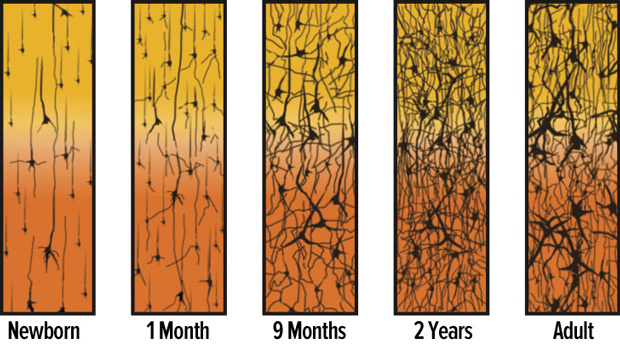How a Baby's Brain Develops – the Key is Love


Written and verified by the psychologist Valeria Sabater
The most important period in the development of a child’s brain is between the ages of 0 and 6. Not only do multiple chemical changes occur, new connections are also made as the baby’s brain begins to increase in size and establish associations.
Let us remember that in the human brain, the pillars of emotional intelligence are settled during the first few years of development.
The way that we interact with our baby and raise them are key to their development. By giving them affection and helping them to mature little by little, we will guarantee they become emotionally healthy and strong adults.
Undoubtedly, managing a child’s needs is a challenge. In fact, to achieve this, we need to understand how our baby’s brain matures.
The better informed we are, the more useful the information can be when it comes time to apply it. We will also be able to know when and how to apply it.
Below are some basic aspects that can allow us to be the support that our children need.
How does the human brain mature?
The brain matures from the inside out and from the back to the front

It seems strange but that’s the way it is. The brain of a newborn as we all know is still very immature.
Just like a flower, it is all about helping it flourish so that it can gradually reach maturity and therefore develop the full potential of which it is capable.
During the post natal stage, the human brain needs to finish settling structures. It establishes connections and forms areas of the brain where basic processes such as information and the following occur:
- Communication
- Movement
- Coordination
- Problem resolution
Up until the age of 3, a child’s brain has twice as many synapses as an adult. That is why it is so important to stimulate babies correctly during the first years of life.
From birth until the age of 3, children’s brains go through an incredible amount of changes. The brain process that we know as synapsis (the connection between neurons) develops progressively. Something that will not be repeated in life after the age of 3
In order for this process to take place efficiently, the child needs to experience prime affective interactions with the people that surround them.
From the inside out and from the back to the front
The human brain consists of several parts, including the one in which the spinal cord is connected to the upper brain. Thanks to this connection, the human being has reflexes and involuntary processes such as breathing and heart rate.
Newborns also have this structure but in their case it is immature.

- Behind the brainstem and under the upper part of the brain is where the cerebellum is found. The cerebellum is involved with processes such as balance and coordination. The cerebellum develops slowly but steadily.
- The baby will mature little by little every day until the development reaches the frontal areas of the brain. In the frontal areas, structures such as the cortex and neocortex are found. They are involved in higher processes such as memory, learning, decision making, problem solving and planning.
It is inside the brain that true magic is found. It is there that you can find the incredible compass that governs a person’s emotional world. Structures such as the limbic system, the amygdala and the hippocampus are all very primitive areas and they all regulate a baby’s behavior.
Stimulate synapsis
Our genes are what allow the brain to reorganize itself based on the experiences it receives from its environment.
If the experiences are positive, stimulating and affectionate, then neuronal activity grows stronger and fights against possible enemies such as fear and stress.
- The repeated use and constant interaction with their environment are external channels that give them internal strength by generating synapses.
- That is why it is important to remember that in order to favor positive connectivity it is essential for us to be constant and maintain a steady parenting style.
- For example, it is ineffective to attend to a crying 6-month old baby and then stop doing that a little bit later because we think that it is time for them to “mature” and grow up.
Until the age of 3, a child does not fully develop a sleep pattern nor have they developed many of the neurological process that would allow them to feel completely safe during the night. They need our closeness.

Key moments in a baby’s brain development
3-6 months: Myelin begins to appear in the axons of some neurons during the second trimester. This process called myelinization continues until adolescence and it allows the child to process information quickly.
6-9 months: The cerebral cortex of the baby begins to develop and acquire potential. They start to interact a lot more with us.
First year: The brain triples in size, the frontal and temporal lobes start to develop and children start to move around with more confidence. They begin to show intense interest in communication.
At the age of 2: The most intense changes occur in the areas of the brain that are related to language.
At the age of 3: These are the magical years. The synapsis density in the prefrontal cortex reaches its maximum splendor. They actually have three times the neuronal connections of that of a fully grown adult. Their only interest is to learn, interact and discover the world with their hands.
If we guide them with love and respect, our babies will undoubtedly grow up to be emotionally strong children and then adults.
All cited sources were thoroughly reviewed by our team to ensure their quality, reliability, currency, and validity. The bibliography of this article was considered reliable and of academic or scientific accuracy.
- Castaño, J. (2005). El sorprendente cerebro del bebé. Archivos argentinos de pediatría, 103(4), 331-337. https://www.sap.org.ar/docs/publicaciones/archivosarg/2005/Castanio.pdf
This text is provided for informational purposes only and does not replace consultation with a professional. If in doubt, consult your specialist.








